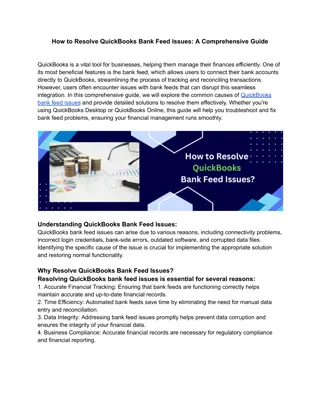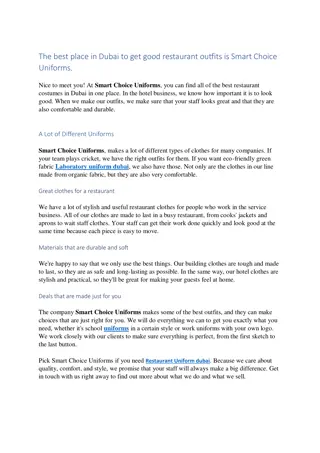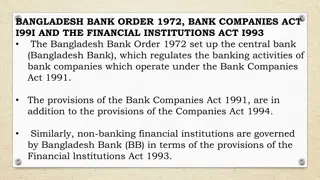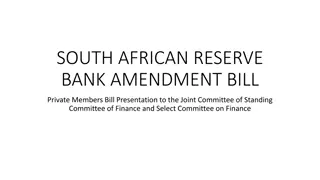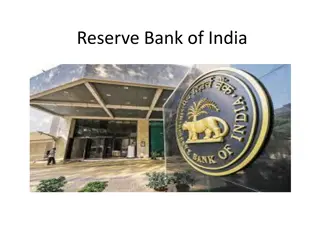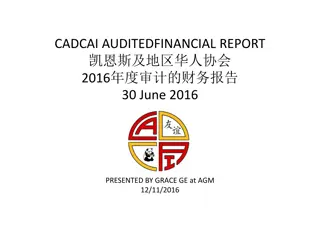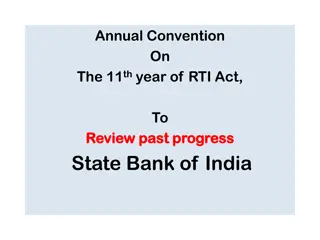Understanding the Uniform Bank Performance Report (UBPR)
The Uniform Bank Performance Report (UBPR) is a crucial tool used by regulatory agencies, the public, and bank management to evaluate a bank's performance in areas such as capital, asset quality, earnings, liquidity, and market risk sensitivity. This report provides detailed data on a bank's financial health, including key ratios, income statement information, and balance sheet details. Learn about the purpose of the UBPR, how to access it, and its significance in analyzing a bank's operations.
Download Presentation

Please find below an Image/Link to download the presentation.
The content on the website is provided AS IS for your information and personal use only. It may not be sold, licensed, or shared on other websites without obtaining consent from the author. Download presentation by click this link. If you encounter any issues during the download, it is possible that the publisher has removed the file from their server.
E N D
Presentation Transcript
Introduction to the UBPR (Uniform Bank Performance Report) 1
Todays Agenda What will we cover today regarding the UBPR? 1. 2. 3. Introduction to the UBPR What is it? Who uses it? What does it contain? How can you get the UBPR? Case Study Valhalla Commerce Bank Director and Officer Use of the UBPR The Director s Dozen 12 Important Issues to Consider 1. Page 1 Summary Ratios 2. Page 3 Noninterest Income and Expenses 3. Page 3 Cost of Funds 4. Page 4 Balance Sheet 5. Page 4 Balance Sheet Liabilities 6. Page 5 Off-Balance Sheet Items and Peer Comparison 7. Page 7B Loans Concentrations 8. Page 8 Analysis of Past Due and Nonaccrual Loans 9. Page 7 Analysis of Credit Allowance and Loan Mix 10. Page 10 Liquidity and Funding 11. Page 10A Liquidity and Investment Portfolio 12. Page 11A Capital Analysis 2
Objectives Obtain a better understanding of the information in the UBPR and where it comes from How to get a UBPR for any insured bank Learn some basic information about the UBPR Learn some key ratios to evaluate a bank s performance 3
UBPR Data Source Consolidated Reports of Condition and Income (Call Reports) are the only data source for the UBPR Banks provide Call Reports data quarterly Accuracy of the Call Report data is crucial At least two directors and an executive officer are required to attest to accuracy of Call Report 4
Overview of the UBPR An analytical tool for regulatory agencies, the public, and bank management Aids in evaluating Capital, Asset Quality, Earnings, Liquidity, and Sensitivity to Market Risk for examination purposes 5
Overview of the UBPR (continued) Data is shown for a specific bank and peer group Bank data includes performance ratios, percentages, and actual dollar amounts Data is provided for five periods Data is organized into summary ratios, income statement information, and balance sheet information 6
How to Obtain UBPRs FDIC s website at www.fdic.gov FFIEC s website at www.ffiec.gov 7
USING THE UBPR Introduction/cover page of the UBPR provides some general information about the bank. Percentile rankings are presented to the right of most of the individual and peer group ratios throughout the UBPR. 8
RATIO ANALYSIS Level and Trend Interrelationship between ratios No single ratio, percentile ranking, or trend is indicative of a bank s financial condition Comparison to similar banks 9
A WALKTHROUGH OF CERTAIN PAGES OF THE UBPR The Director s Dozen Valhalla Commerce Bank 10
Directors Dozen Issue 1 Summary Ratios UBPR page 1 Summary Ratios Net Income results stand out as very noteworthy. Why? What is the Net Interest Margin telling us? 11
Directors Dozen Issue 2 Noninterest Income and Expenses Page 3 of UBPR Noninterest Income and Expenses shows: Comparatively high costs versus peer group in occupancy Why? Comparatively low assets per employee Why? Comparatively low loan yields What may be going on? 12
Directors Dozen Issue 3 Cost of Funds Page 3 provides more information on the Cost of Funds Note the mixed picture of the bank s funding costs. The bank is above market on most, but not all deposit groups. 13
Directors Dozen Issue 4 Balance Sheet Page 4 How has the bank s balance sheet changed recently? Substantial, rapid loan growth Selling securities and eliminating Federal Funds sold The footings remain the same but the bank is vastly different 14
Directors Dozen Issue 5 Balance Sheet - Liabilities Page 4 Liabilities How has the bank s liabilities mix changed? Is it for the better? Significant decline in Demand Deposits and a Core Deposits What may be happening? Capital structure changes? 15
Directors Dozen Issue 6 Off-Balance Sheet Items Page 5 Off-Balance Sheet items Real estate related items have grown significantly. Construction and land development items are significant. Total Off-Balance Sheet items have grown rapidly. Is the total volume of concern? What issue does this create for management? 16
Directors Dozen Issue 6 (continued) Off-Balance Sheet Peer Comparison Page 5 Off-Balance Sheet items Peer Comparison The bank is an outlier compared to Peer What is happening here? Is this a concern? Total Off-Balance Sheet Items (primarily loans) are substantial and significantly elevated as compared to Peer banks 17
Directors Dozen Issue 7 Loan Concentrations Page 7B A very important UPBR page What about the bank s largest asset, LOANS? Is there anything concerning here? Financial Institution Letter 104-2006 entitled Commercial Real Estate Lending Joint Guidance 100% ADC concentration [as % of Total Capital] 300% CRE concentration [these] supervisory criteria may be identified for further supervisory analysis of the level and nature of its CRE concentration risk. What about Total Real Estate concentration? Peer analysis? 18
Directors Dozen Issue 8 Past Due Loans Page 8 Analysis of Past Due and Nonaccrual Loans We have learned a lot about the Loan mix at the bank, but how is the portfolio performing? ADC/CRE concentrations are high, but appear to be performing well. 19
Directors Dozen Issue 9 Loan Loss Reserve Page 7 Analysis of Credit Allowance and Loan Mix Most recent quarter provision expense Average Total Loans are up $11 million over past 12 months No loan losses or recoveries over past 12 months The bank s Loan Loss Reserve balance is low compared to Peer, but does this tell us whether it is appropriately funded? 20
Directors Dozen Issue 10 Liquidity and Funding Page 10 Liquidity and Funding As stated in a previous slide, Core Deposits are shrinking, yet mirror current Peer average. Net Non Core Funding Dependence is rising The Loan-to-Deposit Ratio is increasing, relatively high, and well above Peer. How does that affect the bank? Brokered deposits are relatively low and not a significant source of funds for the bank. 21
Directors Dozen Issue 10 (continued) Liquidity and Funding Page 10 Liquidity and Funding (continued) Over the past 12 months: Total deposits have increased slightly Core deposits have declined FHLB borrowings have increased, and The bank now borrows Federal Funds Most concerning is the rapid growth and reliance upon Non Core funding nearly doubling. What problems does this present management? 22
Directors Dozen Issue 11 Investment Portfolio Page 10A Liquidity and Investment Portfolio Information from this page is mixed . Short term investments are very low as a percent of Total Assets, and very low versus Peer. In the Securities Mix there is a bright spot the bank s portfolio consists of 100% US Treasury and Agency Securities Why is this positive for VCB? Pledging is moderate. 23
Directors Dozen Issue 12 Capital Analysis Page 11A Capital Analysis Tier 1 Leverage Capital is the primary ratio regulators watch VCB scores in the lowest quartile of banks for Tier 1 Capital 24










